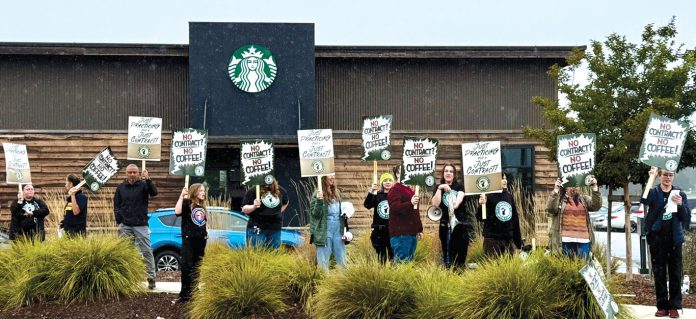
On a drizzly Saturday afternoon in Scotts Valley, the rain came down softly but the voices of Starbucks baristas rose over the din of traffic as they staged a pro-union protest outside of their drive-thru location on Mount Hermon Road.
About a dozen Starbucks employees waved signs and chanted in unison, seeking public support for their efforts to unionize their location.
Handmade signs in hand, the aroma of coffee mingled with chants of solidarity. Among them stood Aidan Hall-Guzmán, a shift supervisor from the 41st Avenue and Soquel Starbucks, there not for himself, but for his colleagues.
“I’m here supporting my constituents here in Scotts Valley,” he said, peeking out from beneath his hoodie. “They have it a lot harder than I do. They’ve got a drive-thru—ours doesn’t—and I know how tough that can be.”
Hall-Guzmán’s own store unionized in March, joining a growing national wave of Starbucks workers organizing under Workers United, a movement that has steadily gained momentum since 2021. His store’s vote was decisive—11 to 2 in favor—and overseen by the National Labor Relations Board (NLRB), the federal agency responsible for administering labor laws.
When asked what it takes to form a union, Hall-Guzmán didn’t hesitate.
“Honestly, it just takes solidarity,” he said. “It’s about knowing there’s strength in numbers, believing in your team and standing together.”
While many Starbucks stores across the country have won union elections, most are still negotiating their first contracts. For Hall-Guzmán, the fight is about more than pay or policies—it’s about mutual respect and collective strength.
“Right now, the biggest thing we have is solidarity,” he explained. “We’re showing the company that we’re united and that we need a contract to be signed unilaterally.”
At the Scotts Valley location—the only drive-thru store in the district—baristas say the workload and stress levels are higher than at other shops. Hall-Guzmán said that’s part of why he came out to support them.
“If anyone needs solidarity with the greater workforce,” he said, “it’s the people who get put between the espresso machine and our customers.”
His phrasing drew laughter from those around him, but his point was clear: Starbucks workers are finding their voice and are asking for better pay, better benefits and more consistent work hours.
The shift supervisor at the drive-thru location was asked for comment but declined to make a statement. Several customers were invited to share their thoughts on the matter, but none opted to speak on the record.
For Hall-Guzmán, who has worked for Starbucks for nearly two and a half years, this movement isn’t just about his store or his job. It’s about shaping the future of work for baristas everywhere.
“It’s a handoff between coworkers, between stores, between people who just want to make things a little better,” he said. “We’re stronger together—always.”
Starbucks Union Movement
As of fall 2025, more than 420 Starbucks stores across the U.S. have voted to unionize:
- The first successful election was in Buffalo, N.Y., in December 2021.
- Organizing efforts are led primarily by Workers United, an affiliate of the Service Employees International Union (SEIU).
- California has over 60 unionized Starbucks locations, including stores in Santa Cruz, Watsonville, Santa Rosa and San Francisco.
- The movement has focused heavily on workload fairness, scheduling stability and consistent benefits for part-time workers.
- Despite widespread union victories, no Starbucks store has yet signed a contract with the company. Negotiations between Starbucks and Workers United remain ongoing nationwide.












